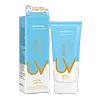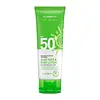What's inside
What's inside
 Key Ingredients
Key Ingredients

 Benefits
Benefits

 Concerns
Concerns

No concerns
 Ingredients Side-by-side
Ingredients Side-by-side

Water
Skin ConditioningDibutyl Adipate
EmollientEthylhexyl Salicylate
UV AbsorberEthylhexyl Triazone
UV AbsorberDiethylamino Hydroxybenzoyl Hexyl Benzoate
UV FilterPropylene Glycol
HumectantPotassium Cetyl Phosphate
EmulsifyingPhenylbenzimidazole Sulfonic Acid
UV AbsorberCetearyl Alcohol
EmollientBis-Ethylhexyloxyphenol Methoxyphenyl Triazine
Skin ConditioningSodium Polyacrylate
AbsorbentTriethanolamine
BufferingCellulose
AbsorbentPhenoxyethanol
PreservativePolyester-7
Skin ConditioningTitanium Dioxide
Cosmetic ColorantPoly C10-30 Alkyl Acrylate
Emulsion StabilisingParfum
MaskingNeopentyl Glycol Diheptanoate
EmollientCeteareth-20
CleansingPotassium Hydroxide
BufferingChlorphenesin
AntimicrobialXanthan Gum
EmulsifyingDisodium EDTA
Dimethicone
EmollientAluminum Hydroxide
EmollientAloe Barbadensis Leaf Juice
Skin ConditioningCocos Nucifera Oil
MaskingTocopheryl Acetate
AntioxidantIsomalt
HumectantStearic Acid
Cleansing1,2-Hexanediol
Skin ConditioningBiosaccharide Gum-4
Skin ConditioningMelanin
Skin ProtectingMalus Domestica Fruit Cell Culture Extract
Skin ConditioningPentylene Glycol
Skin ConditioningLecithin
EmollientVitis Vinifera Fruit Cell Extract
Skin ConditioningGlycerin
HumectantSodium Benzoate
MaskingEthylhexylglycerin
Skin ConditioningAlpha-Isomethyl Ionone
PerfumingCitronellol
PerfumingCoumarin
PerfumingGeraniol
PerfumingHexyl Cinnamal
PerfumingLimonene
PerfumingLinalool
PerfumingWater, Dibutyl Adipate, Ethylhexyl Salicylate, Ethylhexyl Triazone, Diethylamino Hydroxybenzoyl Hexyl Benzoate, Propylene Glycol, Potassium Cetyl Phosphate, Phenylbenzimidazole Sulfonic Acid, Cetearyl Alcohol, Bis-Ethylhexyloxyphenol Methoxyphenyl Triazine, Sodium Polyacrylate, Triethanolamine, Cellulose, Phenoxyethanol, Polyester-7, Titanium Dioxide, Poly C10-30 Alkyl Acrylate, Parfum, Neopentyl Glycol Diheptanoate, Ceteareth-20, Potassium Hydroxide, Chlorphenesin, Xanthan Gum, Disodium EDTA, Dimethicone, Aluminum Hydroxide, Aloe Barbadensis Leaf Juice, Cocos Nucifera Oil, Tocopheryl Acetate, Isomalt, Stearic Acid, 1,2-Hexanediol, Biosaccharide Gum-4, Melanin, Malus Domestica Fruit Cell Culture Extract, Pentylene Glycol, Lecithin, Vitis Vinifera Fruit Cell Extract, Glycerin, Sodium Benzoate, Ethylhexylglycerin, Alpha-Isomethyl Ionone, Citronellol, Coumarin, Geraniol, Hexyl Cinnamal, Limonene, Linalool
 Reviews
Reviews

Ingredients Explained
These ingredients are found in both products.
Ingredients higher up in an ingredient list are typically present in a larger amount.
Dibutyl Adipate is an emollient and solvent. It is created from butyl alcohol and adipic acid.
As a solvent, Dibutyl Adipate helps mix and disperse ingredients evenly.
Dibutyl Adipate is soluble in water and organic solvents. It does not absorb UV rays.
Learn more about Dibutyl AdipateDiethylamino Hydroxybenzoyl Hexyl Benzoate (DHHB) is a chemical UV-A absorber. It is formulated for high UVA protection (320-400 nm).
DHHB is well-liked for:
DHHB has been approved by the EU, Japan, Taiwan, and South America for use up to 10%. Unfortunately, it has not been approved for use in the US or Canada due to slow regulatory processes.
This ingredient is soluble in oils, fats, and lipids.
Learn more about Diethylamino Hydroxybenzoyl Hexyl BenzoateEthylhexyl Triazone is a modern chemical sunscreen that protects from UV-B radiation.
It is the most effective of existing UV-B filters, as it provides the highest level of photo-stable absorption. It protects from the entire UV-B range (280 to 320nm), with it's highest level of protection at 314nm.
Ethylhexyl Triazone is oil soluble, oderless and colorless, which mean it is able to be incorporated into a variety of different formulations.
It is not currently available within the United States due to slow changing FDA regulations. Outside of the US, it is used in formulations at concentrations up to 5%.
Learn more about Ethylhexyl TriazoneGlycerin is already naturally found in your skin. It helps moisturize and protect your skin.
A study from 2016 found glycerin to be more effective as a humectant than AHAs and hyaluronic acid.
As a humectant, it helps the skin stay hydrated by pulling moisture to your skin. The low molecular weight of glycerin allows it to pull moisture into the deeper layers of your skin.
Hydrated skin improves your skin barrier; Your skin barrier helps protect against irritants and bacteria.
Glycerin has also been found to have antimicrobial and antiviral properties. Due to these properties, glycerin is often used in wound and burn treatments.
In cosmetics, glycerin is usually derived from plants such as soybean or palm. However, it can also be sourced from animals, such as tallow or animal fat.
This ingredient is organic, colorless, odorless, and non-toxic.
Glycerin is the name for this ingredient in American English. British English uses Glycerol/Glycerine.
Learn more about GlycerinWater. It's the most common cosmetic ingredient of all. You'll usually see it at the top of ingredient lists, meaning that it makes up the largest part of the product.
So why is it so popular? Water most often acts as a solvent - this means that it helps dissolve other ingredients into the formulation.
You'll also recognize water as that liquid we all need to stay alive. If you see this, drink a glass of water. Stay hydrated!
Learn more about Water